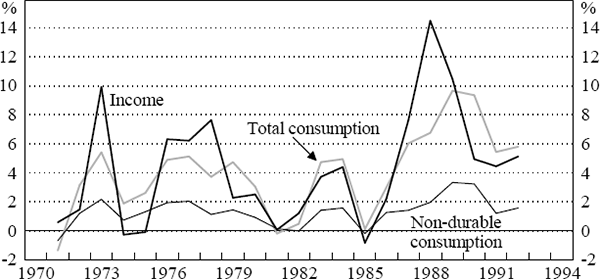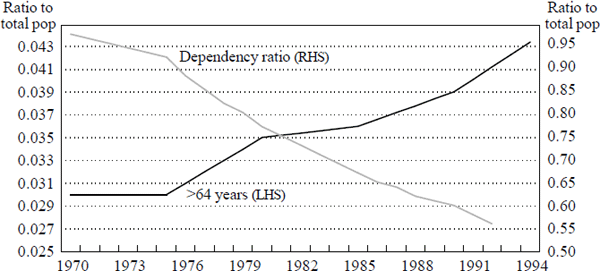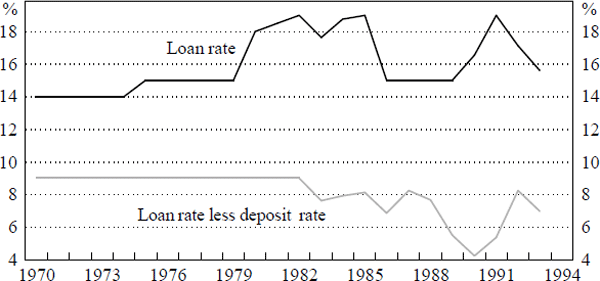RDP 9602: Consumption and Liquidity Constraints in Australia and East Asia: Does Financial Integration Matter? Appendix A: Definitions, Sources and Figures of Data
May 1996
- Download the Paper 346KB
Indonesia
Consumption: total private expenditure 1983 constant prices, ADB Key Indicators and United Nations National Accounts.
Income: gross domestic product, ADB Key Indicators and United Nations National Accounts, deflated by the total private expenditure deflator.
Inflation: deflator(t)/deflator(t−1)−1 from the total private expenditure deflator.
Population statistics: total population and dependency ratio, World Bank Tables, IEDB Database, ANU; proportion aged 64 and over estimated from Keyfitz and Flieger (1990).
Malaysia
Consumption: total private expenditure 1978 constant prices, ADB Key Indicators and United Nations National Accounts.
Income: gross domestic product, ADB Key Indicators and United Nations National Accounts, deflated by the total private expenditure deflator.
Inflation: deflator(t)/deflator(t−1)−1 from the total private expenditure deflator.
Population statistics: total population and dependency ratio, World Bank Tables, IEDB Database, ANU; proportion aged 64 and over estimated from Keyfitz and Flieger (1990).
Philippines
Consumption: total private expenditure 1985 constant prices, ADB Key Indicators and United Nations National Accounts.
Income: gross domestic product, ADB Key Indicators and United Nations National Accounts, deflated by the total private expenditure deflator.
Inflation: deflator(t)/deflator(t−1)−1 from the total private expenditure deflator.
Population statistics: total population and dependency ratio, World Bank Tables, IEDB Database, ANU; proportion aged 64 and over estimated from Keyfitz and Flieger (1990).
Australia
Consumption: non-durables expenditure and total private expenditure 1990 constant prices, Australian Bureau of Statistics (ABS).
Income: household disposable income, ABS, deflated by the total private expenditure deflator.
Deposit rate: 3-month fixed deposit rate at June, 1960–1990, Reserve Bank of Australia (RBA) Australian Economic Statistics, and from 1991, RBA Bulletin.
Loan rate: maximum overdraft rate at June, 1960–1985, RBA Australian Economic Statistics, and from 1991, small and medium sized business rate, RBA Bulletin.
Money market rate: 26-week T-note rate at June, 1960–1990, RBA Australian Economic Statistics, and from 1991, RBA Bulletin.
Inflation: deflator(t)/deflator(t−1)−1 from the total private expenditure deflator.
Population statistics: RBA Australian Economic Statistics, Table 4.2 and ABS.
Money: currency and deposits with banks (M3), RBA Bulletin.
Credit: consumer credit, other personal credit adjusted for breaks, unpublished series, RBA from 1976, before 1976 calendar years are backcast with financial year growth in housing credit, RBA Australian Economic Statistics.
Residential property prices: established house prices in Australian capital cities, index 1989/90 = 100, RBA unofficial series comprising Treasury unpublished series from 1960 to June 1978, REIA series from September 1978 to June 1986 and ABS official series from September 1986 onwards.



Hong Kong
Consumption: non-durables expenditure and total private consumption expenditure 1990 constant prices, provided courtesy of the Hong Kong Monetary Authority.
Income: gross domestic product, World Bank Tables, IEDB Database, ANU.
Deposit rate: annual average 6-month deposit rate 1970–1993, Asian Development Bank (ADB) Key Indicators.
Loan rate: commercial bill rate 1970–1993, ADB Key Indicators.
Inflation: deflator(t)/deflator(t−1)−1 from the total private expenditure deflator.
Population statistics: total population and dependency ratio, World Bank Tables, IEDB Database, ANU; proportion aged 64 and over estimated from Keyfitz and Flieger (1990).
Money: currency and deposits with banks (M2+NCDs), ADB Key Indicators.


Japan
Consumption: non-durables expenditure and total private expenditure 1985 constant prices, Nikkei database.
Income: household disposable income, Nikkei database, deflated by the total private expenditure deflator.
Deposit rate: annual average 3-month fixed deposit rate, IMF International Financial Statistics.
Loan rate: annual average loan rate, IMF International Financial Statistics.
Money market rate: annual average collateralised overnight call money rate, IMF International Financial Statistics.
Inflation: deflator(t)/deflator(t−1)−1 from the total private expenditure deflator.
Population statistics: Nikkei database.
Money: M2+CDs, IMF International Financial Statistics.
Credit: consumer credit from city and regional banks and mutual loan and saving institutions, Nikkei database.
Residential property prices: residential property prices in Japan, Datastream database.



Korea
Consumption: non-durables expenditure and total private expenditure 1990 constant prices, Bank of Korea Annual Statistical Bulletin.
Income: national factor income, Bank of Korea Annual Statistical Bulletin, deflated by the total private expenditure deflator.
Deposit rate: annual average 1-year deposit rate, IMF International Financial Statistics.
Loan rate: annual average curb loan rate, unpublished series, Bank of Korea.
Inflation: deflator(t)/deflator(t−1)−1 from the total private expenditure deflator.
Population statistics: total population and dependency ratio, World Bank Tables, IEDB Database, ANU; proportion aged 64 and over estimated from Keyfitz and Flieger (1990).
Money: currency and deposits with banks, IMF International Financial Statistics.
Credit: household loans, Bank of Korea Annual Statistical Bulletin.



Singapore
Consumption: non-durables expenditure and total private expenditure 1985 constant prices, Department of Statistics Singapore.
Income: gross domestic product, Department of Statistics Singapore, deflated by the total private expenditure deflator.
Deposit rate: annual average 6-month fixed deposit rate Singapore Yearbook of Statistics and ADB Key Indicators.
Loan rate: annual average indicator lending rate Singapore Yearbook of Statistics and IMF International Financial Statistics.
Money market rate: annual average 3-month interbank market rate, Singapore Yearbook of Statistics and IMF International Financial Statistics.
Inflation: deflator(t)/deflator(t−1)−1 from the total private expenditure deflator.
Population statistics: total population, World Bank Tables, IEDB Database, ANU; age classifications, Singapore Annual Statistics.
Money: currency and deposits with banks, IMF International Financial Statistics.
Credit: end-year loans to professionals and private individuals, Monetary Authority of Singapore Statistical Bulletin.
Residential property prices: spliced index of average annual residential property prices 1975 to 1993, Singapore Yearbook of Statistics and Monthly Digest of Statistics Singapore, and index of accommodation costs from the CPI 1970 to 1974, Singapore Yearbook of Statistics.



Taiwan
Consumption: non-durables expenditure and total private expenditure 1991 constant prices, Statistical Yearbook of the Republic of China.
Income: factor income, Statistical Yearbook of the Republic of China, deflated by the total private expenditure deflator.
Deposit rate: end-year 3-month fixed deposit rate Taiwan Statistical Data Book.
Loan rate: end-year secured loan rate Taiwan Statistical Data Book.
Inflation: deflator(t)/deflator(t−1)−1 from the total private expenditure deflator.
Population statistics: Taiwan Statistical Data Book, adjusted for break in 1969.
Money: currency and deposits with banks, IMF International Financial Statistics.
Credit: end-year loans and discounts of all banks to individuals and others, Taiwan Statistical Data Book.

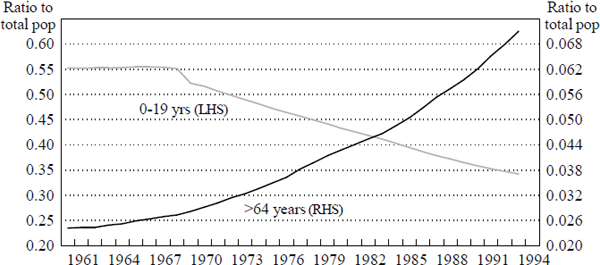
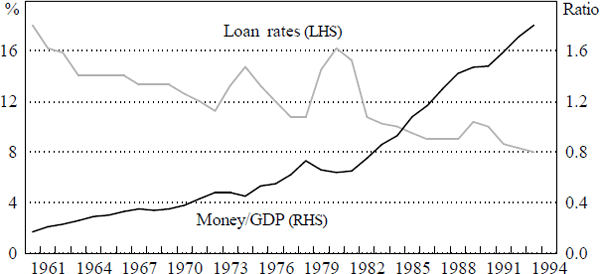
Thailand
Consumption: non-durables expenditure and total private expenditure 1988 constant prices, Statistical Yearbook Thailand, ADB Key Indicators and United Nations National Accounts.
Income: personal disposable income, Statistical Yearbook Thailand, deflated by the total private expenditure deflator.
Deposit rate: annual average 3–6-month fixed deposit rate, Bank of Thailand Monthly Statistical Bulletin and ADB Key Indicators.
Loan rate: annual average maximum lending rate, Bank of Thailand Monthly Statistical Bulletin and ADB Key Indicators.
Money market rate: annual average weighted interbank market rate, Bank of Thailand Monthly Statistical Bulletin.
Inflation: deflator(t)/deflator(t−1)−1 from the total private expenditure deflator.
Population statistics: total population and dependency ratio, World Bank Tables, IEDB Database, ANU; proportion aged 64 and over estimated from Keyfitz and Flieger (1990).
Money: currency and deposits with banks, IMF International Financial Statistics.
Credit: end-year loans for personal consumption, Bank of Thailand Monthly Statistical Bulletin.
